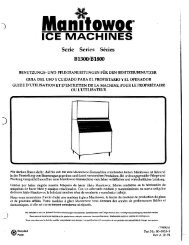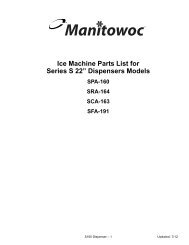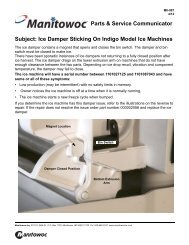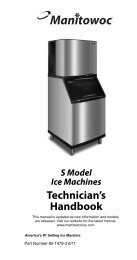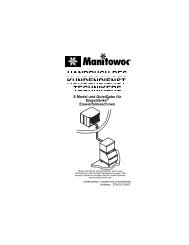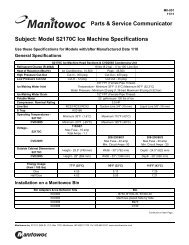S1800 Marine Model Ice Machines – Service Manual - Manitowoc Ice
S1800 Marine Model Ice Machines – Service Manual - Manitowoc Ice
S1800 Marine Model Ice Machines – Service Manual - Manitowoc Ice
You also want an ePaper? Increase the reach of your titles
YUMPU automatically turns print PDFs into web optimized ePapers that Google loves.
Refrigeration System Section 7<br />
DISCHARGE LINE TEMPERATURE ANALYSIS<br />
General<br />
Knowing if the discharge line temperature is increasing,<br />
decreasing or remaining constant can be an important<br />
diagnostic tool. Maximum compressor discharge line<br />
temperature on a normally operating ice machine<br />
steadily increases throughout the freeze cycle.<br />
Comparing the temperatures over several cycles will<br />
result in a consistent maximum discharge line<br />
temperature.<br />
Ambient air temperatures affect the maximum discharge<br />
line temperature.<br />
Higher ambient air temperatures at the condenser and/<br />
or higher inlet water temperature = higher discharge line<br />
temperatures at the compressor.<br />
Lower ambient air temperatures at the condenser and/or<br />
lower supply water temperature= lower discharge line<br />
temperatures at the compressor.<br />
Regardless of ambient and water temperatures, the<br />
freeze cycle discharge line temperature will be higher<br />
than 160°F (71.1°C) on a normally operating ice<br />
machine.<br />
Procedure<br />
Connect a temperature probe on the compressor<br />
discharge line with-in 6" of the compressor and insulate.<br />
Observe the discharge line temperature for the last three<br />
minutes of the freeze cycle and record the maximum<br />
discharge line temperature.<br />
Discharge Line Temperature Above 160°F (71.1°C) At<br />
End Of Freeze Cycle:<br />
<strong>Ice</strong> machines that are operating normally will have<br />
consistent maximum discharge line temperatures above<br />
160°F (71.1°C).<br />
Discharge Line Temperature Below 160°F (71.1°C) At<br />
End Of Freeze Cycle<br />
<strong>Ice</strong> machines that have a flooding expansion valve will<br />
have a maximum discharge line temperature that<br />
decreases each cycle.<br />
Verify the expansion valve sensing bulb is 100%<br />
insulated and sealed airtight. Condenser air contacting<br />
an incorrectly insulated sensing bulb will cause<br />
overfeeding of the expansion valve.<br />
Verify the expansion valve sensing bulb is positioned<br />
and secured correctly.<br />
7-16 Part Number 80-1634-3





